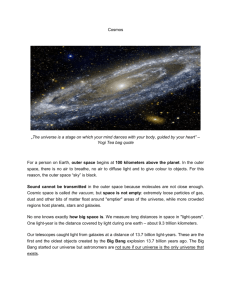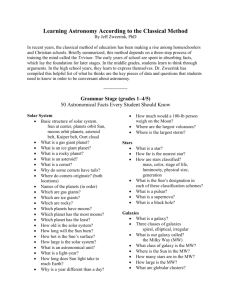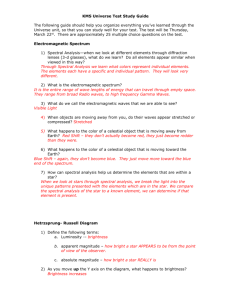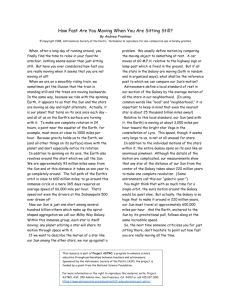Astronomy Notes
advertisement
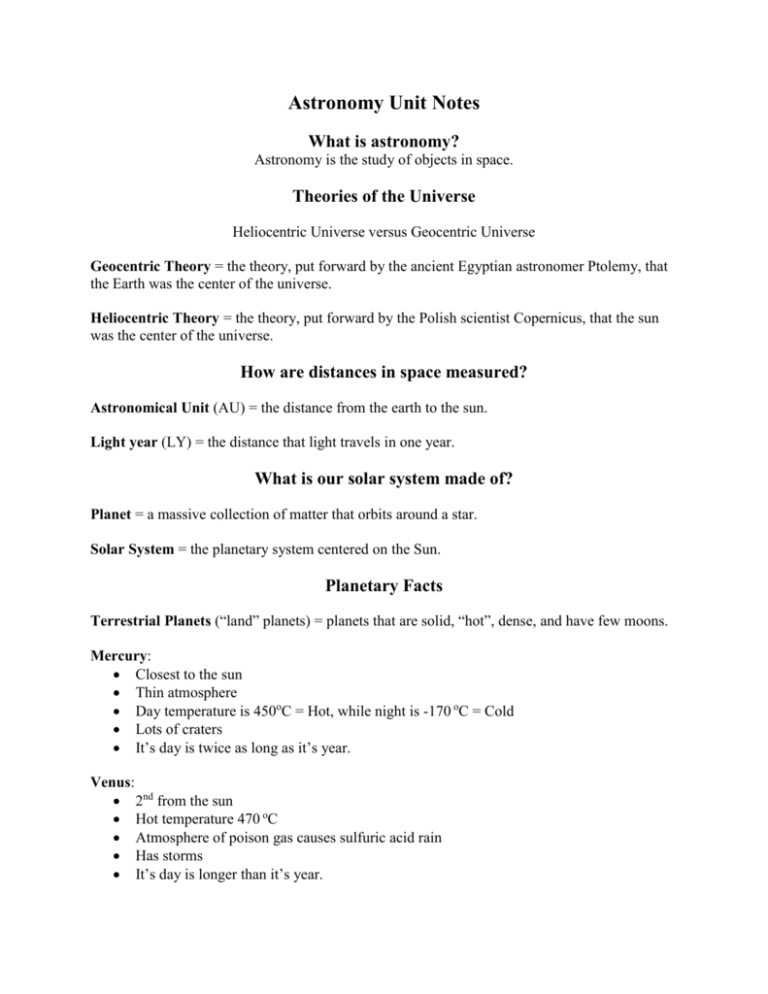
Astronomy Unit Notes What is astronomy? Astronomy is the study of objects in space. Theories of the Universe Heliocentric Universe versus Geocentric Universe Geocentric Theory = the theory, put forward by the ancient Egyptian astronomer Ptolemy, that the Earth was the center of the universe. Heliocentric Theory = the theory, put forward by the Polish scientist Copernicus, that the sun was the center of the universe. How are distances in space measured? Astronomical Unit (AU) = the distance from the earth to the sun. Light year (LY) = the distance that light travels in one year. What is our solar system made of? Planet = a massive collection of matter that orbits around a star. Solar System = the planetary system centered on the Sun. Planetary Facts Terrestrial Planets (“land” planets) = planets that are solid, “hot”, dense, and have few moons. Mercury: Closest to the sun Thin atmosphere Day temperature is 450oC = Hot, while night is -170 oC = Cold Lots of craters It’s day is twice as long as it’s year. Venus: 2nd from the sun Hot temperature 470 oC Atmosphere of poison gas causes sulfuric acid rain Has storms It’s day is longer than it’s year. Earth: 3rd from the sun Only known planet with liquid water Average temperature is ~ 12 oC Has one moon Has ice caps on poles. Mars: 4th from the sun Called the “Red Planet” due to large amounts of iron oxide (rust) on surface Also called the sister to earth Rocky composition Temperature range is -20 oC to -140 oC Has polar ice caps. Gas Giants (Gaseous planets) = planets that are big, cold, low density, with lots of moons and rings. Jupiter: 5th from the sun Larger than all the other planets combined High gravity makes the gas into a liquid and therefore there are “oceans” Great Red Spot is a storm on the surface of the planet that is ~ 3 times the size of earth Jupiter has 16 moons. Saturn: 6th from the sun 2nd largest planet in solar system Has a low density, it would float in water Rings are made of particles of ice, dust and rock Saturn has 20 moons. Uranus: 7th from the sun Planets axis is tilted on it’s side Green/blue color is from methane gas, hydrogen and helium composition Uranus has thin rings and 15 moons. Neptune: 8th from the sun Blue color is from methane gas composition Great Dark Spot is a storm on the surface Neptune has 8 moons, moon Triton is mostly nitrogen = possible atmosphere. Pluto: Cold planet Rocky composition Pluto has one moon, Charon, almost as large as Pluto itself Not all astronomers consider Pluto a planet. What are the other objects in the solar system? Comet = a large chunk of ice, dust, frozen gas and rock fragments that moves through space. Comets form in the icy cloud called the Oort Cloud as gravity of a passing star pulls material out of the cloud. Comets have two tails o Ion tail always points away from the sun o Dust tail is left behind in the comets path of travel Asteroid = a large chunk of rock traveling through space. Most, not all, are found in the asteroid belt located between Mars and Jupiter. Meteoroid = a small piece of rock moving through space. Meteor = a small piece of rock moving through space (a meteoroid) that enters Earth’s atmosphere. Meteorite = a small piece of rock moving through space that hits the Earth. What are stars? How do stars form? Star = a hot, glowing sphere of gas that produces energy by fusion (of hydrogen molecules). Some stars produce more energy therefore they are hotter. Nebula = a cloud of dust and gas where stars are born. Here gravity pulls particles together and fusion starts at 10,000,000 oC and a star is born. Stars are classified by temperature and color. “HOT” BLUE “COLD” WHITE YELLOW ^ OUR SUN ORANGE RED BROWN Brightness = stars are also classified by their brightness. There are two types of brightness, actual and apparent. Actual brightness = how bright a star really is. Actual brightness does not change, it is an absolute value. Example: a 40 watt light bulb is actually converting 40 watts of energy into light. Apparent brightness = how bright a star looks from earth. Apparent brightness changes depending on distance from earth and viewing conditions (atmosphere). Example: a 40 watt light bulb 10 feet away appears brighter than a 40 watt bulb 100 feet away. Life Cycle of a Star Stars are born (in nebulas), they age (change from “hot” to “cold”), then they die out (go nova or supernova). Supernova = when the core of a star collapses and the outer portion explodes. This is the “death of a star”. What remains when a star dies out depends on the mass of the star. The most massive stars collapse into black holes. Black Hole = the most dense things known to exist in the universe. The gravity of a black hole is so great that even light cannot escape the pull of a black hole. What is our Sun? Our Sun is an average star of yellow-orange classification. Sun spot = a dark, cooler spot on the surface of the sun. Prominence / Flares = bright spots on the sun formed as gas particles shoot outward from the sun. These affect the magnetic fields on earth (radio, television, communications). These also cause the Northern Lights or “Aurora Borealis”. Corona = the outer layer of the sun. This is the gradual boundary between the sun and space. This is what we see during an eclipse. Photosphere = the layer of the sun that is incredibly bright and the source of much of the light we see on earth. Chromosphere = is an active layer of the sun that is where the magnificent displays of prominence and flares take place. Where in the Universe Are We? Galaxy = a large group of stars, gas and dust held together by gravity. Our galaxy is called the Milky Way Galaxy and it is comprised of about 200 billion stars. There are three types of galaxies: (see diagrams for pictures of each type of galaxy). Elliptical galaxies = are groups of stars that appear to be shaped like an ellipse (football) Spiral galaxies = are groups of stars that appear to have a dense concentration of stars in the center and arms that are made of stars and dust. o A “Barred” Spiral galaxy looks similar to a spiral galaxy with a “bar” of stars through the center and the arms extend outward from the ends of the “bar”. Irregular galaxies = are groups of stars that appear to be together but have no regular shape. As stars are grouped into galaxies, galaxies are grouped into clusters. Cluster = a group of galaxies. Our cluster is called the Local Group. So where in the Universe is our Earth? The “astronomical address” for earth would read; Earth is the 3rd planet in the Solar System of the star called Sun, which is in the Milky Way Galaxy, which is in the Local Group of galaxies in the universe.


